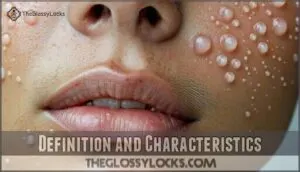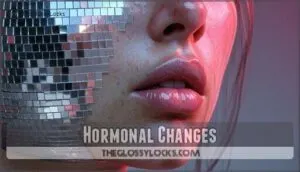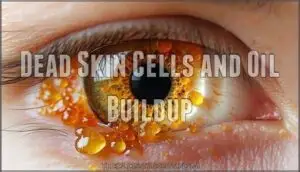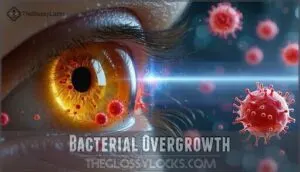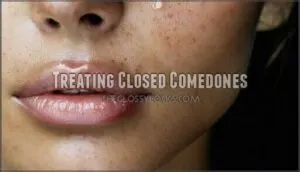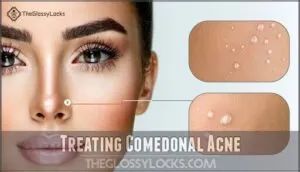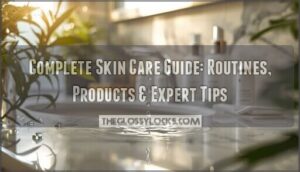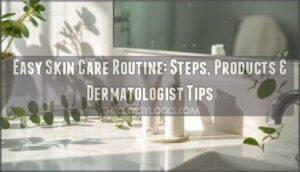This site is supported by our readers. We may earn a commission, at no cost to you, if you purchase through links.
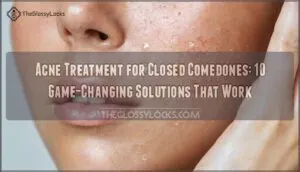
Look for products with salicylic acid to unclog pores and retinoids to encourage cell turnover. Exfoliate gently to prevent buildup, but don’t overdo it, as harsh scrubbing can make things worse.
If over-the-counter options aren’t cutting it, prescription creams or in-office procedures like chemical peels might help.
Lifestyle tweaks, like reducing stress and avoiding comedogenic products, can also work wonders. Remember, treating closed comedones takes consistency and patience—think marathon, not sprint.
Curious about the best ingredients to pair? There’s more to explore ahead!
Table Of Contents
- Key Takeaways
- What Are Closed Comedones
- Causes of Closed Comedones
- Preventing Closed Comedones
- Treating Closed Comedones
- Closed Comedones Treatment Options
- Managing Closed Comedones
- Closed Comedones and Hormonal Acne
- Treating Comedonal Acne
- Reducing Closed Comedones
- Effective Closed Comedones Treatment
- Frequently Asked Questions (FAQs)
- What is the best treatment for closed comedones?
- What is the best treatment for comedonal acne?
- What is the best face treatment for comedonal acne?
- Why am I getting so many closed comedones?
- Can stress worsen the appearance of closed comedones?
- Are certain fabrics more likely to irritate comedones?
- How does weather affect closed comedones?
- Does hydration level impact closed comedone severity?
- Can specific hairstyles or accessories cause closed comedones?
- Conclusion
Key Takeaways
- Use salicylic acid or retinoids to unclog pores, clear buildup, and prevent new closed comedones.
- Stick to a gentle skincare routine with non-comedogenic products and avoid squeezing or harsh scrubbing.
- Manage excess oil and dead skin cells through consistent cleansing, exfoliation, and lightweight moisturizers.
- Consult a dermatologist for persistent cases or consider in-office treatments like chemical peels or prescription retinoids.
What Are Closed Comedones
Those small, skin-colored bumps on your face are closed comedones, formed when oil and dead skin cells block your pores beneath the skin’s surface.
Closed comedones are tiny, stubborn bumps formed when trapped oil and dead skin cells clog pores beneath the skin’s surface.
Unlike blackheads, they don’t have an opening to the surface, which is why they appear as white or flesh-colored bumps that can’t be easily squeezed.
Definition and Characteristics
Beneath your skin’s surface, closed comedones are non-inflammatory blemishes that form when pores become blocked.
You’ll recognize these whiteheads as small, flesh-colored bumps that create an uneven skin texture.
Unlike inflammatory acne, closed comedones don’t typically appear red or painful.
They’re basically trapped debris—oil, dead skin cells, and bacteria—that can’t escape from the follicle, resulting in skin congestion that’s visible but not inflamed.
Types of Comedones
Understanding those pesky bumps starts with knowing the different types of comedones.
Closed comedones (whiteheads) hide under your skin, while open comedones (blackheads) expose themselves to air.
You might also encounter microcomedones (tiny, often invisible), macrocomedones (larger than 2mm), or giant comedones (large cysts with blackhead-like openings).
These noninflammatory acne forms typically don’t contain pus or cause redness, making comedonal acne different from inflammatory varieties.
Causes and Risk Factors
Several factors contribute to closed comedones formation.
Your skin’s overactive sebum production combined with dead skin cells creates the perfect storm for pore clogging.
Hormonal fluctuations, especially during puberty or menstruation, can trigger excess oil.
Genetic predisposition plays a role, as does skin irritation from harsh products.
Lifestyle factors like diet, stress, and inadequate cleansing can worsen comedonal acne, turning your clear complexion into a bumpy battlefield.
Causes of Closed Comedones
Your closed comedones form when excess oil combines with dead skin cells, trapping bacteria beneath your skin’s surface and creating those frustrating bumps.
Hormonal changes can worsen this condition by increasing oil production, particularly during your menstrual cycle or periods of stress.
Hormonal Changes
Hormonal changes often trigger those pesky closed comedones you’ve been battling.
Your body’s fluctuating hormone levels, especially during your menstrual cycle, can increase oil production in your skin.
Four ways hormones contribute to closed comedones:
- Testosterone spikes during puberty onset stimulate excess sebum production
- Estrogen fluctuations throughout your monthly cycle affect skin clarity
- Pregnancy effects include androgen sensitivity changes
- Hormonal imbalances can lead to persistent hormonal acne
Dead Skin Cells and Oil Buildup
Dead skin cells and excess oil create the perfect storm for closed comedones. When keratinocytes accumulation meets increased sebum production, your pores become battlegrounds for clear skin.
| Contributor | How It Affects Pores | Solution |
|---|---|---|
| Dead skin cells | Block follicle openings | Regular exfoliation |
| Excess sebum | Creates sticky buildup | Oil-free products |
| Lipid abnormalities | Thickens oil consistency | Benzoyl peroxide |
| Cytokine production | Triggers inflammation | Anti-inflammatory ingredients |
| Environmental factors | Traps debris in pores | Daily cleansing |
The combination of these factors leads to pore blockage and can cause various skin issues, emphasizing the importance of proper skin care routines, including the use of products like Benzoyl peroxide to maintain healthy skin.
Bacterial Overgrowth
Bacteria play a significant role in your closed comedones development. Specific bacterial strains, particularly P. acnes, thrive in the oil-rich environment of blocked pores, worsening inflammation.
- Microbiome balance disruption leads to bacterial overgrowth on skin
- Inflammation cascade triggers when bacteria multiply within pores
- Antibiotic resistance can develop with improper acne treatment
- Benzoyl peroxide effectively reduces bacterial counts without creating resistance
Topical antibiotics and retinoids work together to address both bacterial overgrowth and pore blockage.
Preventing Closed Comedones
You can prevent closed comedones by maintaining a consistent skincare routine with gentle cleansers and oil-free products that remove excess sebum and dead skin cells.
Maintain clear skin by using gentle cleansers and oil-free products to keep excess oil and dead skin cells at bay.
Combining regular exfoliation with a balanced diet low in sugar and dairy will substantially reduce your risk of developing these stubborn, under-the-skin bumps, which can be achieved through a routine that includes gentle cleansers.
Skincare Routine
A consistent skincare routine is your first line of defense against closed comedones.
Wash your face twice daily with a gentle cleanser that removes excess oil without stripping your skin. Incorporate exfoliation 2-3 times weekly using products with salicylic acid to clear pores.
Always follow with noncomedogenic moisturizers to maintain hydration. Remember, product order matters—cleanse, treat, hydrate.
Topical retinoids can be game-changers when used properly in your nightly routine.
Lifestyle Modifications
Beyond skincare products, your daily habits substantially impact closed comedone formation. Making small changes can yield big results for clearer skin.
- Maintain adequate hydration levels by drinking 8-10 glasses of water daily
- Prioritize 7-8 hours of quality sleep to support skin repair
- Implement stress reduction techniques like meditation or yoga, as stress hormones can trigger oil production
Always use noncomedogenic skincare products and practice gentle exfoliation to prevent buildup, which can help achieve healthier skin.
Dietary Changes
Your diet plays a vital role in preventing closed comedones.
Limit milk and reduce sugar intake, as these dietary factors can trigger acne flare-ups. Stay hydrated throughout the day to flush toxins.
Consider adding anti-inflammatory foods like berries and leafy greens to your meals. Maintaining gut health through probiotics and fiber-rich foods can also improve your skin’s appearance.
A healthy diet supports effective acne prevention.
Treating Closed Comedones
You can effectively treat closed comedones using targeted products containing ingredients like salicylic acid, retinoids, or benzoyl peroxide that break down the buildup of oil and dead skin cells.
Consistent application of these treatments, combined with gentle exfoliation, will gradually clear your pores and prevent new comedones from forming, which is a key concept related to using retinoids.
Over-the-Counter Products
Now that you’ve established a prevention routine, let’s look at effective OTC options for treating closed comedones.
The right over-the-counter products can make a significant difference in your skin’s appearance.
Here are 5 powerful OTC solutions with proven efficacy:
- Benzoyl peroxide cleansers (2.5-5%) to kill acne-causing bacteria
- Salicylic acid (1-2%) exfoliants that penetrate pores
- Adapalene gel (Differin) for gentle retinoid treatment
- Azelaic acid suspensions to reduce inflammation
- Sulfur-based spot treatments for targeted application
Apply these noncomedogenic products as directed for best results. For cystic acne, benzoyl peroxide is effective.
Prescription Medications
When over-the-counter products fall short, prescription medications can be your skin’s knight in shining armor.
Topical retinoids like tretinoin and adapalene clear pore blockages while smoothing skin.
For hormonal causes, your dermatologist might recommend spironolactone, which benefits women by reducing male hormone effects.
Prescription combinations often yield better results than single treatments, though stronger retinoid strength may cause initial irritation.
Remember, antibiotic use isn’t typically effective for purely comedonal acne.
In-Office Procedures
Professional in-office procedures can effectively target closed comedones.
Manual extraction by a dermatologist removes blockages safely.
Microdermabrasion benefits skin texture, while chemical peels encourage renewal.
Cryotherapy details show it freezes stubborn pores.
Electrosurgery risks include minor scarring but work for resistant cases.
These treatments, when handled professionally, complement other methods for clearer, smoother skin.
Always consult a dermatologist for guidance on using microdermabrasion and other treatments to achieve the best results.
Closed Comedones Treatment Options
You’ll find several effective treatment options for those stubborn closed comedones, including topical retinoids, azelaic acid, and salicylic acid that work by unclogging pores and promoting skin cell turnover.
These clinically proven solutions target the root causes of closed comedones by dissolving excess oil and removing dead skin cells that lead to clogged pores, which is a key process involving cell turnover.
Topical Retinoids
Dermatologists consider topical retinoids the gold standard for closed comedones treatment.
These vitamin A derivatives (tretinoin, adapalene, tazarotene) work by increasing cell turnover and preventing clogged pores.
Apply a pea-sized amount to clean, dry skin at night, starting with 2-3 times weekly. You’ll likely experience initial dryness or peeling as your skin adjusts.
Many users find product selection essential for effective results. Most patients see significant improvement after 8-12 weeks of consistent use.
Azelaic Acid
While retinoids work wonders, azelaic acid offers another powerful approach to tackle closed comedones.
This primary comedolytic prevents new comedones from forming and helps with existing ones.
- Works as an alternative to benzoyl peroxide with fewer side effects
- Reduces hyperpigmentation left by acne while treating active breakouts
- Can be combined with salicylic acid for enhanced results
For best closed comedones treatment results, apply products like Paula’s Choice 10% Azelaic Acid Booster once or twice daily.
You’ll need patience—improvement typically takes several weeks.
Many people use non-comedogenic moisturizers to avoid clogged pores.
Salicylic Acid
Consistently, salicylic acid (SA) works wonders for closed comedones by penetrating deep into your pores.
This oil-soluble BHA exfoliates by dissolving the bonds between dead skin cells. For best results, apply products with 0.5-2% SA concentration once daily.
A suitable facial cleanser can help maintain clear skin.
While mild dryness is common, this powerhouse ingredient substantially reduces comedonal acne over time. If irritation occurs, consider gentler alternatives like PHAs or mandelic acid.
Managing Closed Comedones
You’ll need a consistent approach to effectively manage those stubborn closed comedones that create an uneven skin texture.
Regular gentle exfoliation combined with non-comedogenic products will help clear current bumps and prevent new ones from forming, which is crucial for achieving a smoother skin texture through regular gentle care.
Exfoliation Techniques
Now that we’ve explored treatment options, let’s look at how proper exfoliation can transform your skin’s texture.
Regular exfoliation removes dead skin cells that contribute to closed comedones. You have three main options: chemical peels with salicylic or glycolic acid, physical exfoliation with gentle scrubs, or enzyme exfoliation for sensitive skin.
Consider skin type when selecting the best method for your skin. Start with twice weekly exfoliation, then adjust based on your skin’s response.
Always follow with moisturizer for post-exfoliation care.
Avoiding Harsh Products
During your fight against closed comedones, harsh products can worsen skin irritation and damage your skin barrier.
Switch to gentler alternatives that won’t trigger breakouts.
- Choose noncomedogenic skincare formulated for sensitive skin
- Check product ingredients for known irritants like alcohol and fragrance
- Prioritize gentle cleansing with pH-balanced cleansers
- Maintain hydration importance with lightweight moisturizers
- Always perform patch testing before trying new products to ensure you’re using the right products for your skin, and to avoid further irritation, keeping your skin healthy is crucial, and gentle cleansing is key.
Reducing Inflammation
Inflammation can worsen closed comedones, turning small bumps into angry, red blemishes.
To reduce this reaction, incorporate calming ingredients like niacinamide or centella asiatica into your skincare routine.
Gentle cleansing prevents irritation, while dietary anti-inflammatories (omega-3s and antioxidants) help from within.
Topical soothers containing aloe vera or green tea extract provide immediate relief.
Don’t forget stress reduction techniques—they’re essential for managing comedonal acne.
Closed Comedones and Hormonal Acne
Your hormones can trigger excess oil production and skin cell buildup, creating those stubborn closed comedones that appear during your cycle.
Treatments that target hormonal imbalances, such as certain birth control pills and androgen-blocking medications, can help regulate oil production and prevent these frustrating bumps from forming, which is a result of excess oil production.
Hormonal Fluctuations
Hormonal fluctuations can send your skin into chaos.
During your menstrual cycle, especially before your period, increased hormone levels trigger excess oil production that clogs pores, creating more closed comedones.
Androgen sensitivity makes some people more prone to comedonal acne during puberty.
Stress hormones can worsen the situation by stimulating oil glands.
Understanding these patterns helps predict breakouts, allowing you to adjust treatments like retinoids accordingly.
Birth Control and Acne
Beyond hormone shifts, your birth control pill can be a powerful ally against closed comedones.
Combination pills containing estrogen and progestin reduce testosterone levels and sebum production.
FDA-approved options like those with drospirenone or cyproterone acetate often work better than others for acne.
You’ll typically see improvements after 2-3 months of consistent use, though your doctor might recommend combining oral contraceptives with other acne treatments for the best results.
Androgen Inhibitors
While birth control helps many women with hormonal acne, androgen inhibitors offer another powerful option.
These medications block the effects of male hormones (androgens) that trigger excess oil production and closed comedones.
- Spironolactone benefits include reduced oil production and fewer breakouts
- Winlevi (clascoterone) is the first topical anti-androgen for acne
- Off-label uses of certain medications target hormonal imbalances
- Side effects may include redness, dryness, or itching
- Prescription creams containing clascoterone work by preventing testosterone from producing sebum
Treating Comedonal Acne
To treat comedonal acne, you’ll need a consistent skincare routine that prevents clogged pores.
Using medicated creams, adjusting your habits, and considering natural remedies can help reduce these stubborn bumps over time.
Adjusting Skincare Habits
Making small changes to your skincare habits can dramatically reduce closed comedones.
Your daily facial cleansing routine forms the foundation of effective treatment.
Always use noncomedogenic skincare products and introduce new items gradually with patch testing.
Sun protection is essential regardless of weather conditions.
| Habit Adjustment | Benefit | Implementation |
|---|---|---|
| Gentle Cleansing | Prevents irritation | Twice daily with mild cleanser |
| Product Order | Maximizes effectiveness | Thinnest to thickest consistency |
| Tool Hygiene | Reduces bacteria | Clean applicators weekly |
Using gentle cleansing and maintaining tool hygiene are crucial for preventing irritation and reducing bacteria.
It is also important to follow the correct product order to maximize effectiveness.
Medicated Creams and Gels
When addressing comedonal acne, medicated creams and gels offer targeted solutions for stubborn closed comedones.
These topical medications penetrate pores to clear existing blockages and prevent new formations.
- Retinoids like Tretinoin and Adapalene in various strengths loosen comedones
- Benzoyl peroxide works by killing bacteria, though concerns include dryness
- Salicylic acid’s efficacy lies in its ability to exfoliate inside pores
- Azelaic acid benefits include reducing inflammation while clearing pores
- Combination therapies often yield better results than single treatments
Using tretinoin for comedones is a popular approach.
Natural Remedies
While medicated treatments are effective, natural remedies offer gentler alternatives for closed comedones.
Tea tree oil‘s antiseptic properties fight bacteria when properly diluted.
Witch hazel balances skin moisture and opens clogged pores.
Honey repairs and cleanses with its antibacterial qualities.
| Natural Remedy | Benefits | Usage Tips |
|---|---|---|
| Tea Tree Oil | Antiseptic, fights bacteria | Always dilute before applying |
| Witch Hazel | Balances moisture, opens pores | Use up to twice daily |
| Honey | Repairs pores, dries acne | Apply as mask or cleanser |
Reducing Closed Comedones
You can effectively reduce closed comedones by using gentle, non-comedogenic skincare products that clear pores without causing irritation.
A consistent routine that includes regular exfoliation with ingredients like salicylic acid or retinoids will prevent the buildup of dead skin cells and excess oil that leads to these stubborn bumps, utilizing a method that is both gentle and non-comedogenic.
Gentle Skincare Products
Harsh products can worsen comedonal acne.
Gentle skincare products form the cornerstone of your closed comedones treatment plan. When building your skincare routine, look for pH-balanced cleansers that won’t strip your skin’s natural oils.
Ingredient Spotlight: Ceramides and hyaluronic acid help maintain your moisture barrier while treating acne.
For sensitive skin, fragrance-free formulations minimize irritation. Proper application techniques (using light, upward motions) enhance product effectiveness during long-term use.
Avoiding Comedogenic Ingredients
Now that you’ve found gentle products, let’s talk ingredient awareness.
Reading product labels can save your skin from closed comedones. Check the comedogenicity scale (0-5) before purchasing – anything rated 3 or higher might trigger pore blockage.
Oil-containing products are common hidden culprits, especially coconut oil and cocoa butter. When in doubt, look for "non-comedogenic" on packaging.
Safe alternatives include hyaluronic acid and niacinamide-based formulations.
Maintaining Healthy Skin
Maintaining healthy skin keeps closed comedones at bay.
Focus on a balanced skincare routine and mindful habits to prevent pore blockage.
- Sun protection: Use non-comedogenic sunscreen daily.
- Hydration habits: Drink plenty of water and use a gentle moisturizer.
- Diet’s impact: Limit processed foods and sugary snacks.
- Stress management: Practice relaxation techniques for better skin and sleep quality.
A consistent routine should include gentle exfoliation twice a week.
Effective Closed Comedones Treatment
To effectively treat closed comedones, you need a consistent routine and the right combination of active ingredients.
It’s important to monitor your skin’s response over time, making adjustments as needed for desirable results, using a consistent routine to achieve the best outcome with the right combination of active ingredients.
Consistency and Patience
Sticking to a consistent routine is like watering a plant—you won’t see results overnight, but steady care pays off.
Acne treatment for closed comedones demands patience and treatment adherence. Realistic expectations help you stay motivated as gradual improvement unfolds over months of skincare dedication.
Break free from quick fixes; invest in long-term results.
| Key Focus | What to Do | Why It Matters |
|---|---|---|
| Consistent Routine | Follow daily regimen | Supports steady progress |
| Treatment Adherence | Use products regularly | Prevents setbacks |
| Patience | Avoid rushing results | Builds lasting change |
Using these strategies will help you achieve the desired outcome of steady progress and lasting change.
Combining Active Ingredients
Combining active ingredients helps tackle closed comedones effectively.
With proper layering techniques, you can boost synergy benefits while avoiding irritation.
Follow a structured approach:
- Use retinoids first to unclog pores.
- Add azelaic acid for its anti-inflammatory effects.
- Apply beta hydroxy acid (BHA) to exfoliate deeply.
Consistency guarantees long-term effects on comedonal acne without compromising skin health, ensuring proper layering is crucial.
Monitoring Progress and Adjusting Treatment
Tracking your acne treatment for closed comedones is essential. Evaluate your skincare routine regularly, noting treatment efficacy and side effects.
Persistent comedones might need routine adaptation or a dermatologist consult.
Use this table to simplify:
| Step | Action |
|---|---|
| 1. Assess | Check for visible changes |
| 2. Adjust | Modify retinoids dosage |
| 3. Consult | Visit dermatologist, if needed |
Stay consistent, but flexible!
Frequently Asked Questions (FAQs)
What is the best treatment for closed comedones?
Treat closed comedones with salicylic acid or retinoids to unclog pores and prevent buildup.
Add a non-comedogenic moisturizer, avoid squeezing bumps, and consider a dermatologist for persistent cases or prescription treatments like adapalene.
Consistency matters, and following these steps can help manage closed comedones, with treatments like adapalene providing additional support.
What is the best treatment for comedonal acne?
Battling comedonal acne is like solving a tricky puzzle.
Use gentle cleansers, exfoliate with salicylic acid, and apply retinoids.
Avoid squeezing bumps.
For stubborn spots, see a dermatologist for stronger prescriptions or in-office treatments, which may include retinoids.
What is the best face treatment for comedonal acne?
For comedonal acne, stick with a routine: cleanse gently twice daily, exfoliate weekly with salicylic acid, and use retinoids like adapalene.
Avoid oil-based products, touch your face less, and consult a dermatologist for persistence.
Why am I getting so many closed comedones?
You’re likely getting so many closed comedones due to excess oil, dead skin cells, or hormonal changes clogging your pores.
Factors like harsh skincare, poor cleansing, or certain products can also worsen the issue.
Can stress worsen the appearance of closed comedones?
Stress can trigger hormone fluctuations, ramping up oil production and worsening clogged pores.
If you’re feeling frazzled, it’s like giving your skin an extra workout—resulting in more closed comedones.
Breathe deep, care for yourself, and your skin.
Are certain fabrics more likely to irritate comedones?
Certain fabrics, like polyester and wool, can trap sweat and oils, irritating your skin and worsening comedones.
Stick to breathable, natural materials like cotton to reduce friction and keep pores clear of buildup.
How does weather affect closed comedones?
When the weather gets humid, your pores can feel like they’re suffocating, leading to extra oil buildup and closed comedones.
Cold, dry weather, on the other hand, may trap dead skin, clogging pores even more, which can be considered an extra issue.
Does hydration level impact closed comedone severity?
Your hydration level plays a role in skin health, but it won’t directly cause or prevent closed comedones.
Staying hydrated helps balance oil production and supports healing, so drink water, but don’t skip proper skincare!
Can specific hairstyles or accessories cause closed comedones?
Tight hairstyles, headbands, and hats can trap sweat, oil, and bacteria, clogging your pores and causing closed comedones.
Avoid wearing them for long periods, and keep accessories clean to minimize breakouts.
Conclusion
Addressing closed comedones effectively takes diligence and informed choices.
By incorporating proven strategies like gentle exfoliation, balancing active ingredients like salicylic acid and retinoids, and maintaining a non-comedogenic skincare routine, you can minimize these bumps.
If progress stalls, consider prescription treatments or professional options like chemical peels.
Consistency is key—acne treatment for closed comedones isn’t instant but achievable with patience.
Stay proactive, monitor your skin’s response, and adjust as needed to find what works best for you.

